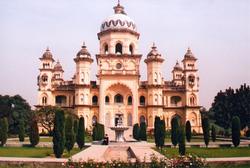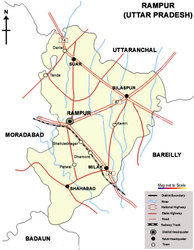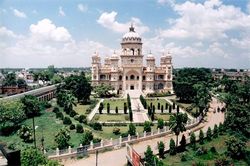MY CITY
My City-RAMPUR
Rampur is located between Longitude 78-0-54 & 69-0-28 East and Latitude 28-25 & 29-10 North. Spread in area of 2367 Sq. Km falls in Moradabad Division of Uttar Pradesh State. It is surrounded by District Udham Singh Nagar in North, Bareilly in East, Moradabad in West and Badaun in South. The height from sea level is 192 Meter in north and 166.4 m in South. Situated on the national highway 24, the state capital is 302 km in East and national capital is 185 km in West. It is well connected by Railways & Roadways.
BRIEF HISTORY
The state of Rampur was founded by Nawab 'Ali Muhammad Khan, the adopted son and successor of Sardar Daud Khan, chief of the Rohillas in Northern India. He received the territory known as Kather from Emperor Muhammad Shah in 1737, but then lost virtually everything in a contest with the Nawab Wazir of Oudh in 1746. Two years later, he assisted Ahmad Shah Durrani in his invasion of India and thus recovered all his former possessions in reward. At his death, he divided his territories equally amongst his many sons. Faizu'llah Khan, the second son, receiving those around Rampur and Chachait. He was confirmed in his possessions by a treaty with Oudh, which was guaranteed by the HEIC, 7th October 1774. Thereafter, the Rohilla chiefs and their troublesome followers were encouraged to settle peaceably within the borders of the new state.
Despite the fearsome warlike history of his clan, Nawab Faizu'llah Khan, was a remarkably gifted and far-sighted ruler. Conversant in a number of languages, he laid the foundations of one of the most prestigious libraries in Asia. Now known as the Rampur Raza Library, it contains more than 15,000 manuscripts in Arabic, Urdu, Persian and Turkish, many of them priceless and ancient. Amongst its treasures, a Koran written before 661 by the fourth Caliph, 'Ali bin Abu Talib.
Nawab Muhammad Ali Khan succeeded his father in 1793, but was deposed by his nobles within twenty-four days. His younger brother and successor, Ghulam Muhammad, proved tyrannical and a danger to his subjects and neighbours alike. This coupled with a fear of resurgent Rohilla aggression, prompted intervention by a combined force belonging to the Nawab Wazir of Oudh and the HEIC. Nawab Ghulam Muhammad Khan was deposed in favour of his nephew, Nawab Ahmad Ali Khan. The latter ruled for forty-four prosperous years, greatly enhancing the cultural and artistic environment of his realm. He became tributary to the HEIC when the whole of Rohilkand was transferred to the company in 1801.
Nawab Muhammad Said, younger son of Ghulam Muhammad, succeeded his cousin in 1840, but was clearly cut from a different cloth than his father. Benevolent and progressive, he established courts of law and an advanced legal framework, formed a modern army out of feudal levies, built irrigation works and developed several projects aimed at increasing the economic welfare of his people.
Nawab Muhammad Yusuf 'Ali Khan, son and successor of Muhammad Said, inherited a near model state and did much to enhance his father's example. He assisted the British authorities during the Mutiny in 1857, receiving many honours and lands for his efforts. Nevertheless, he did much to preserve the Mughal heritage of the country by inviting and sponsoring court scholars, musicians and artists to settle in Rampur, after the dissolution of the Imperial court in 1858. Amongst these many beneficiaries, the renowned poet and chronicler, Ghalib.
Nawab Kalb-i-Ali Khan was highly literate in Arabic and Persian, and consequence expanded the famous library several times over, patronising scholars from all-over India and the Muslim world. He did much to improve education and was responsible for constructing the famous mosque, the Jama Masjid, at a cost of Rs. 3 Lakhs. His son, Nawab Mustaq Ali Khan, continued many of his good works, but concentrated especially on architectural and irrigation works.
Nawab Hamid Ali Khan, succeeded his father aged fourteen in 1889 and reigned for forty-one years. A benevolent and modern ruler, like his predecessors, he vastly expanded the number of schools and educational institutions within his state and also donated very generously to colleges of higher learning in other parts of India. Aligarh Muslim University and Lucknow Medical College are amongst two of the many institutions which owe their existence to his generosity. His army saw service in several theatres of war, including Afghanistan, the Middle East and East Africa.
Nawab Raza Ali Khan, who became Nawab in 1930, inherited his father's energetic and modern-thinking Dewan, Colonel Zaidi. Together, they expanded industrialisation at breathtaking speed. Within ten years of the Nawab's succession, the canal system was vastly expanded, electrification projects completed, roads, sanitation systems and schools constructed, and factories and industrial concerns had sprung up everywhere. Though a Muslim ruler, with a majority of Muslim subjects, the Nawab greatly expanded the employment of Hindu's in state service, and half his Council of Ministers were Hindus. Like his father, he volunteered the services of his forces on the outbreak of the Second World War and soldiers from his state served with distinction in the Middle East, in Africa and South East Asia.
Rampur acceded to the Dominion of India in 1947, and merged with the United Provinces in 1950. Thereafter, the Nawab devoted himself to his many educational, cultural and charitable activities. Foremost among these, his place as the Muslim head of the Masonic organisation in a secular state, overwhelmingly composed of devout Hindus. At his death he had left instructions for his burial at Karbala in Iraq, a feat that was only accomplished after two years of intense negotiations between the Indian government and the secular and hostile Ba'athist regime.
Nawab Raza Ali Khan's descendants continue to engage in public affairs within modern, democratic India. Both his sons served as members of parliament, either at the union level in Delhi or in the state legislature. His daughter-in-law, likewise served as a popular and indefatigable representative of the people in the Indian Parliament. Similarly, his grandson and the current head of the Rampur family, Nawab Syed Muhammad Kazim 'Ali Khan, has served as a Cabinet Minister in the state government.
THERE IS A LOT TO KNOW ABOUT RAMPUR. APART FROM BEING A PRINCELY STATE IT IS ONE OF THE MOST PEACEFUL PLACES WITH COMMUNAL HARMONY AND A GLORIOUS PAST. TO KNOW MORE ABOUT RAMPUR LOG ON TO THE OFFICIAL WEBSITE OF RAMPUR. THERE ARE VARIOUS OTHER WEBSITES ALSO FROMWHERE YOU CAN GET LOT OF INFORMATION ON RAMPUR.
MORE ABOUT RAMPUR
The Royal family of Rampur (the Nawabs) sided with the British during the Indian Rebellion of 1857 and this enabled them to continue to play a role in the social, political and culture life of South Asia in general and the Muslims of South Asia in particular. They gave refuge to some of the literary figures from the Court of Bahadur Shah Zafar. The family continues to be significant. Important members include Sahabzada Yaqub Khan.
In the medieval period Rampur was usually controlled by whoever was the ruler of Delhi at the time, and was divided between Badayun and Sambhal districts. Being situated in the Northern part of Rohilkhand, it was known by the name of Kather and was ruled by Katheria Rajputs. The Katheria Rajputs fought for about 400 years with the rulers of Delhi and later with the Mughals. They fought against Nasiruddin Mahmud in 1253, Ghiyasuddin Balban in 1256, Jalaluddin Firoz in 1290, Firoz Shah in 1379 and Sikander Lodhi in 1494. In 1623 two Afghan brothers of the Rohilla tribe, Shah Alam and Husain Khan, settled here and founded a small state, bringing with them many other Pashtun settlers. Ali Muhammad Khan, grandson of Shah Alam, united the Rohillas between 1707 and 1720, making Bareilly his capital. His uncle, Hafiz Rahmat Khan, who succeeded him, extended his power from Almora in the North to Etawah in the South-West.
The Rohilla War of 1774-5 began when the Rohillas reneged on a debt they owed the Nawab of Oudh for military assistance against the Marathas in 1772. The Rohillas were defeated and driven from their former capital of Bareilly by the Nawab of Oudh with the assistance of the East India Company's troops. The Rohilla State of Rampur was established by Nawab Faizullah Khan on October 7, 1774 in the presence of British Commander Colonel Champion, and remained a pliant state under British protection thereafter. The first stone of the new Fort at Rampur was laid in 1775 by Nawab Faizullah Khan. Originally it was a group of four villages named Kather, the name of Raja Ram Singh. The first Nawab proposed to rename the city 'Faizabad'. But many other places were known by the name Faizabad so its name was changed to Mustafabad Alias RAMPUR. Nawwab Faizullah Khan ruled for 20 years. He was a great patron of scholarship, and began the collection of Arabic, Persian, Turki and Urdu manuscripts which now make up the holdings of the Rampur Raza Library. After his death his son Muhammad Ali Khan took over, but he was killed by the Rohilla Leaders after 24 days, and Ghulam Muhammad Khan, the brother of the deceased, was proclaimed Nawab. The East India Company took exception to this, and after a reign of just 3 months and 22 days Ghulam Muhammad Khan was defeated by its forces, and the Governor-General made Ahmad Ali Khan, son of the late Muhammad Ali Khan, the new Nawab. He ruled for 44 years. He did not have any sons, so Muhammad Sa'id Khan son of Ghulam Muhammad Khan took over as the new Nawab. He raised a regular Army, established Courts and carried out many works to improve the economic conditions of farmers. His son Muhammad Yusuf Ali Khan took over after his death. His son Kalb Ali Khan became the new Nawab after his death in 1865.
Nawab Kalb Ali Khan was literate in Arabic and Persian. Under his rule the state did much work to uplift standards of education. He was also a Member of Council during the Viceroyalty of Lord John Lawrence. He built the Jama Masjid in Rampur at a cost of Rs. 3 Lakhs. He was also knighted in Agra by the Prince of Wales. He ruled for 22 years and 7 months. After his death his son Mushtaq Ali Khan took over. He appointed W. C. Wright as the Chief Engineer of the estate. He built many new buildings and canals. Nawab Hamid Ali became the new ruler in 1889 at the age of 14. Many new schools were opened during his reign, and lots of donations were provided to nearby colleges. He donated Rs. 50,000 to Lucknow Medical College. In 1905 he built the magnificent Darbar Hall within the Fort which now houses the great collection of Oriental manuscripts held by the Rampur Raza Library. His son Raza Ali Khan became the last ruling Nawab in 1930. On July 1, 1949 the State of Rampur was merged into the Republic of India. Rampur today presents a slightly decayed appearance: the palaces of the Nawabs are crumbling, as are the gates and walls of the fort. However, the Library remains a flourishing institution of immense value to scholars from all over the world.
From Wikipedia, the free encyclopedia
For more information on Rampur you can visit the official website of Rampur. To visit the official website of Rampur click HERE. You can also get information about Rampur on other websites like This or click Here.
The Rampur Raza Library is a treasure house of Indo Islamic learning and Art. It was founded by Nawab Faizullah Khan in 1774 AD.After the independence and merger of Rampur State in the Union of India, the library was brought under the management of a Trust till the Govt. of India took over the library on 1st July 1975 under the Act of Parliament which declared it as an institution of National importance.
The Rampur Raza Library is one of the World's magnificient, unparalled respository of cultural heritage and treasure-house of knowledge built up by successive Nawabs of Rampur State. It contains very rare and valuable collection of manuscripts, historical documents, specimens of Islamic calligraphy, miniature paintings, astronomical instruments and rare illustrated works in Arabic and Persian languages besides 80,000 printed books.
Conceived and personal collection of manuscripts, miniatures specimens of Islamic calligraphy in the last decades of the 18th century, the founder of Rampur State, Nawab Faizullah Khan who ruled the state from 1774 to 1794, established the library with his personal modest collection kept in the Tosha Khana of his Palace. As all the Nawabs were the great patrons of scholars, poets, painters, calligraphers and musicians, the Library occupied the pivotal place of all Library and publication activities. With this humble beginning, the library grew by leaps and bounds and notable addtions were made to the collection during the rule of Nawab Ahmad Ali Khan ( 1794-1840).For more information on Raza Library you can visit the official site by clicking HERE
Insert Another Sub Header Here
| Rampur Greyhound | ||
|---|---|---|
| Rampur Greyhound | ||
| Alternative names | ||
| North-Indian Greyhound Rampur Hound | ||
| Country of origin | ||
| India | ||
| Classification and breed standards | ||
| Not recognized by any major kennel club |
The Rampur Greyhound is native to the Rampur region of Northern India, which lies between Delhi and Bareilly.The Rampur hound is a member of the big sighthound family. In North West of India it is often described as a smooth haired sighthound, substantially built. It was the favored hound of the Maharajahs for jackal control, but was also used to hunt lions, tigers, leopards, and panthers. It was considered a test of courage for a single hound to take down a jackal. The Rampur is built to cover great distances at high speed; thus capable of great endurance.
His Royal Highness Ahmed Ali Khan Bahadur bred these dogs by combining the blood lines of very powerful but ferocious Tazi, brought in by the Afghans, and the English Greyhound that was more obedient but less resistant to the varying climatic conditions. He gave the name 'Rampur Hound' to the dogs he bred. The Rampur Hound far exceeded the his expectations. From its Tazi and Afghan ancestors it got its looks and stalwart character, and from the English Greyhound it got its speed. Here was a dog that would seldomly back down in confrontations, and could more or less keep up with the fastest prey.
With the fall of the Maharajahs from power in 1947, so too, fell the popularity of the Rampur Hound. The effect of the arrival of the English was evident to the Rampur, as well as the native Indian people. The English greyhound was bred into some of the lines, making it very find a purebred Rampur Greyhound.
For more information on Rampur Greyhound click on the link below
Click Here to View the DetailsInsert Another Sub Header Here
Rampuri
The rampuri is an indian gravity knife of formidable reputation having a single edged blade roughly 9 to 12 inches long. Usually it is the switchblade type but there step-lock type available as well. It formed the basic weapon for indian thugs or "goondas" during the beginningof the 19th century. The name rampuri comes from the town called Rampur in Uttar Pradesh, India whose description is given above. The royal bladesmiths of local Nawabs started making the knives after the popularization of fire arms after the 18th century.
The rampuri is used even to this day by the local indian mafia although sophisticated automatic pistols have largely taken their place. However, Indian law prohibits making such knives longer than 6 inches of blade length. This word has become more popular in the indian cinema where most of the goondas are having rampuri knife. In other words Rampur is better known by "Rampuri Chaaku".It was and is also a now diminishing cottage industry just like lock industry in Aligarh or Scissors in Meerut.




